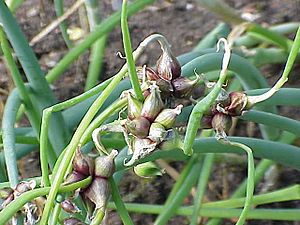Tree onion facts for kids
Quick facts for kids Tree onion |
|
|---|---|
 |
|
| Onion stalks with bulblets, or miniature onions grown at the top of the stalk. | |
| Scientific classification | |
| Genus: |
Allium
|
| Species: |
× proliferum
|
The tree onion (Allium × proliferum) is a perennial plant. This means it grows back year after year. It looks a lot like a regular common onion. However, instead of flowers, it grows small, mini-onions called bulblets at the top of its stalks.
Tree onions are also known by other fun names. People call them topsetting onions, walking onions, or Egyptian onions. Scientists have found that tree onions are a mix of two other plants. They are a shallot and a Welsh onion.
Contents
How Tree Onions Grow
Tree onion bulblets are special. They can sprout and grow while still on the original plant stalk. These bulblets are usually small, about the size of a marble. They can be from 0.5 to 3 centimeters wide.
Sometimes, the weight of these new growing bulblets makes the stalk bend down. The bulblets then touch the ground and take root. This allows a new plant to grow a little distance from the parent plant. This is why they are called "walking onions."
The name "Egyptian onion" might come from a long time ago. Some people think the Romani people brought these onions to Europe from India. Other plants, like some types of garlic, also grow bulblets instead of flowers. These can sometimes be called top onions too.
What Tree Onions Are Like
Tree onions can also be called "turfed stone leek." Farmers can grow them to sell, both for their leaves and their bulbs. They are like a shallot that can grow well in warm, tropical places.
Many tree onions have a very strong flavor. But some types are milder and sweeter. The parts that grow underground are tough and have a strong smell. They can be long, like leeks. Some types can form round bulbs up to 5 centimeters across.
Cooking with Tree Onions
Young tree onion plants can be used like scallions in the spring. The small bulblets can be used in cooking just like regular onions. You can also preserve them by pickling them.
Tree Onions in Japan
In Japan, this plant is known as wakegi. It means "split scallion." It is a special plant in the Hiroshima Prefecture. People use it in local cooking, similar to how other scallions are used.
Tree Onions in Korea
In Korea, tree onions are called jjokpa. They are a type of pa, which means "scallion." Regular onions are called yangpa, meaning "Western scallion."
Jjokpa is often the main ingredient in many Korean dishes. Other types of scallions, like daepa (big scallion) or silpa (thread scallion), are usually used as a spice or garnish. Popular dishes made with jjokpa include pajeon (scallion pancakes) and pa-kimchi (scallion kimchi).
Images for kids
-
Pa-kimchi (scallion kimchi)





